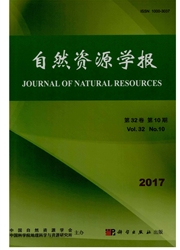

 中文摘要:
中文摘要:
由于泾河流域地理位置的特殊性,气候、降水、地形、人类活动等的区域性,从不同区间的空间角度分析泾河流域的土地利用/覆盖变化情况具有重要的意义。文章利用泾河流域1970s-2006年的4期遥感影像分类结果,结合年降水量由南向北逐渐减少的情况,将流域划分为北、中、南3个功能区,从定量的角度揭示了不同功能区土地利用变化的时空规律,初步探讨了这些规律形成的主要自然、经济和政策成因。结果表明:①1970s-1990s,泾河流域植被覆盖总体呈下降趋势,在20世纪90年代后期开始实行一系列的生态保护措施后,植被覆盖开始恢复;②泾河流域的城镇用地、耕地、林地、高覆盖度草地在流域中部和南部分布更广,低覆盖度草地则主要分布在流域北部。由于气候、降水等自然条件的变化,人口增加、经济发展等社会因素的影响,流域由南到北,植被恢复速度逐渐趋缓;③流域北部由于自身自然环境条件较差,气候变暖、降水减少、土地退化、水土流失以及相关政策等因素在其土地利用变化中起主要作用。而人类活动、经济发展等社会因素对人类活动强度相对较大的流域中部和南部影响更大。
 英文摘要:
英文摘要:
Because of special geo-location,and having territorial climate,precipitation,terrain,soil property,human effect and so on,the analysis on the LUCC of the Jinghe River basin from the spatial angle has important meanings.Based on the ERDAS IMAGINE software and some background information,this study took the supervised classification method to analyze the land use change characteristics in the Jinghe River basin from the 1970s to 2006.Because the annual precipitation decreased from south to north,the basin was divided into three sections of the north,the middle and the south,for the purpose of investigating the spatial difference of land use structures in independent sections during the last 40 years and discussing some natural,economic and political causes for the different varieties. The conclusions of the study can be drawn as follows: 1) With the elapse of time,we can see that the vegetation in Jinghe River basin had a downward trend during the 1970s to the 1990s.Viewing from the percentage of the different land use types in the whole basin,the forest reduced from 17.59% to 12.13%,however,the unused land increased from 3.08% to 12.35%.After taking some ecological protections in the late 1990s,vegetation and environment began to restore obviously.The low coverage grassland had an evident restoration rate,and then the high coverage grassland,whereas the forest had more difficult to restore.2) Most of the farmland,forest and high coverage grassland were distributed in the middle and the south sections,so was the urban land,however,the low coverage grassland was mainly distributed in the north section.From south to north,as the environment changed,the recovery rate also became slowly.During the 1970s to 2006 the low coverage grassland increased to 61% of the north section,however,the high coverage grassland still reduced.In the middle,after the decrease in the 1970s to the 1990s,the high coverage grassland and the low coverage grassland both had an increasing trend,and the land use dynamic degrees were 6.75%
 同期刊论文项目
同期刊论文项目
 同项目期刊论文
同项目期刊论文
 Remote detection of bare soil moisture using a surface-temperature-based soil evaporation transfer c
Remote detection of bare soil moisture using a surface-temperature-based soil evaporation transfer c Estimation of Daily Evapotranspiration by Vapotranspiraton by Three-Temperatures Model at Large Catc
Estimation of Daily Evapotranspiration by Vapotranspiraton by Three-Temperatures Model at Large Catc Water use efficiency and evapotranspiration of winter wheat and its response to irrigation regime in
Water use efficiency and evapotranspiration of winter wheat and its response to irrigation regime in Ameliorative effect of mulching on water use efficiency of Swiss chard and salt accumulation under s
Ameliorative effect of mulching on water use efficiency of Swiss chard and salt accumulation under s 期刊信息
期刊信息
